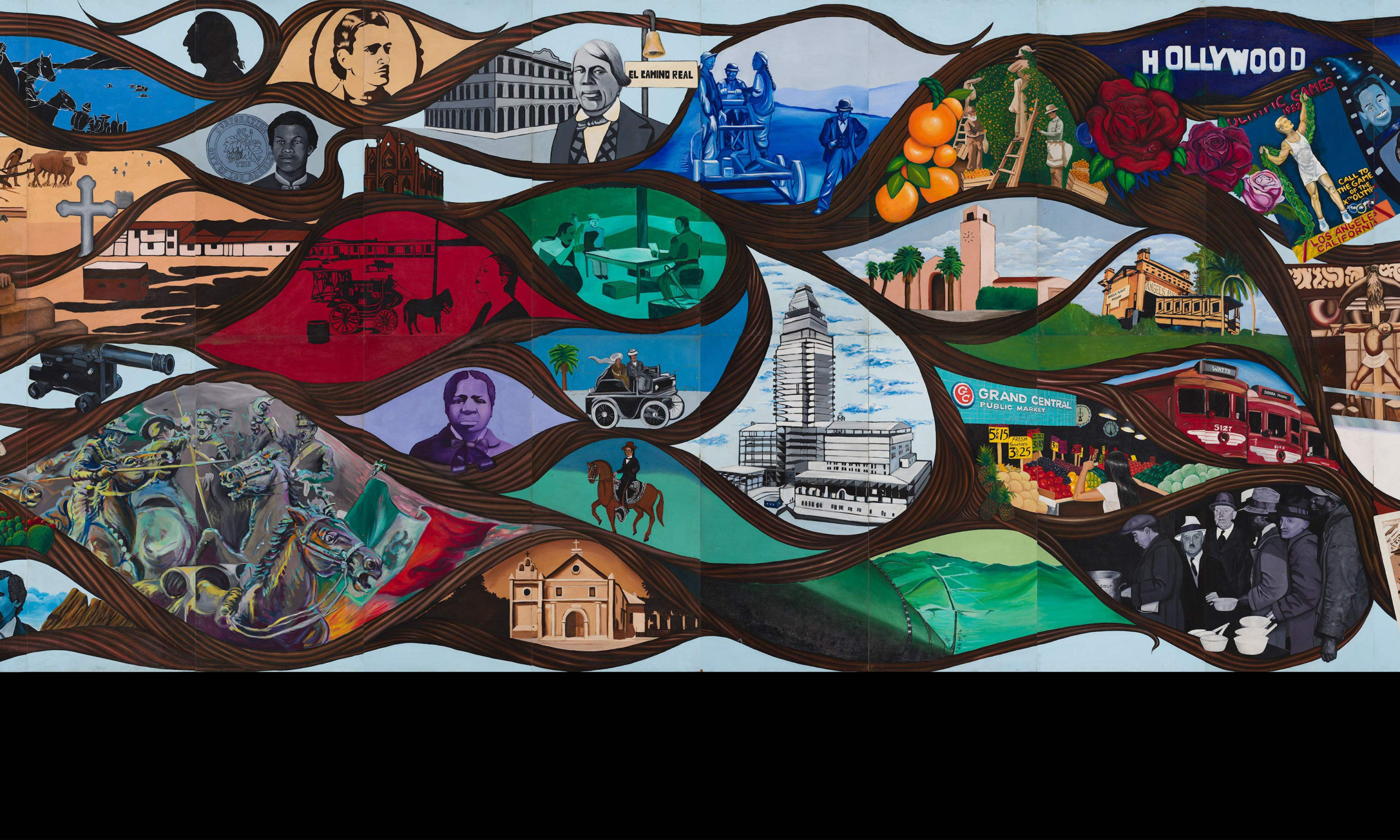The Queen of the Angels’ story: Barbara Carrasco’s 80ft-long mural goes on permanent display soon at the Natural History Museum in Los Angeles
© Barbara Carrasco
This autumn, a mural once censored by the Community Redevelopment Agency (CRA) of Los Angeles will have pride of place in the new welcome centre of the Natural History Museum of Los Angeles County (NHM). Commissioned in 1981 to celebrate the bicentennial of the city’s founding, the mural project ended abruptly when the artist Barbara Carrasco refused CRA demands for the removal of more than a dozen scenes it deemed controversial, and L.A. History: A Mexican Perspective went into storage for decades, with occasional public appearances. After the 80ft-long mural featured in the NHM exhibition Sin Censura: A Mural Remembers Los Angeles in 2018-19, the museum acquired it in 2020.
Founded in 1913, the NHM is one of the largest natural history museums in the US, with more than 35 million objects. A new chapter begins this autumn with the unveiling of NHM Commons, a garden and welcome wing freely accessible from the street it shares with the Lucas Museum of Narrative Art, still under construction. The $75m renovation and expansion project encompasses 50,000 sq. ft of interior space and 25,000 sq. ft of new landscaping.
The impending arrival of the Lucas Museum prompted action, along with other factors the museum had long been pondering, says Lori Bettison-Varga, the NHM’s president and director since 2015. During strategic planning, she says, “we were thinking about the role of our museum within the community and how to be more engaged with community—where community needs were and how to meet those needs with our programmes. And then ultimately, offering a space where people felt that they were welcomed.” Another concern was to have a functioning and flexible theatre. “We haven’t had a space to really properly put on events.”
The architecture firm of Frederick Fisher and Partners, known for its work with museums and educational institutions, designed the building and its interior; Studio-MLA designed the landscaping, including the existing entrance area on Exposition Boulevard. In the new plan, visitors can enter through a drought-tolerant garden from the south-west side of the museum, and get a taste of museum offerings in the long lobby, buy tickets and pick up a snack at the cafe. The new black-box theatre with retractable seating for up to 400 is located off the lobby.
Prehistoric co-star
The lobby is flanked by two aspects of the museum. On one side, natural history is represented by a 70ft-long sauropod skeleton, unusual for being green, the bones having absorbed minerals from the Utah riverbed where they were found. On the other side, human history is recounted in Carrasco’s acrylic-on-masonite mural, which depicts 51 scenes and people from the history of Los Angeles. She had three assistants for the epic project—Glenna Avila, Rod Sakai and Yreina D. Cervantez—plus help from students from Los Angeles County’s youth employment programme.
Carrasco spent months doing research for the mural and approached Bill Mason, the in-house historian at the NHM, for guidance. He told her that the original name of the city was El Pueblo de la Reina de Los Ángeles (the Town of the Queen of the Angels), which sparked her imagination. “He had a really great archive of early Los Angeles history,” Carrasco says. “He let me borrow these photos from the museum’s collection, and I used those to create the mural images.” The images are folded into the braids of the Virgin Mary, who is the Queen of the Angels.
In the mural, the queen faces left—Carrasco had her sister model—with vignettes tracing the city’s history from left to right. They go from prehistoric creatures gathering around a watering hole and the early human settlers (the Gabrieleño or Tongva) to the arrival of the Spanish and the establishment of the San Gabriel mission.
Carrasco also included portraits of the people who made Los Angeles. They include Pio Pico, the last governor of Alta California under Mexican rule, Biddy Mason, a 19th-century African American woman who was a successful real estate developer and philanthropist, and Dolores Huerta, a civil rights activist and the co-founder of the United Farm Workers of America trade union.
Fourteen of those scenes and portraits upset the CRA. “They objected strongly to the Japanese internment scene,” Carrasco recalls. The image depicts a young girl sitting on a suitcase, about to be sent to one of the prison camps set up by the US government during the Second World War to hold Japanese Americans. Carrasco adds: “I think there were 10 or 12 individuals on the CRA board, and they were all white men.”
Rendering of the mural in situ at the Natural History Museum
Courtesy Natural History Museum of Los Angeles County
She consulted three Japanese American organisations “and they said, ‘Of course, this is the negative chapter in our history, but it has to be included because it happened, and it shouldn’t be repeated.’”
The CRA also objected to Carrasco’s depiction of the Los Angeles Chinese massacre of 1871, the Zoot Suit Riots of 1943 and another act of artistic censorship—the whitewashing of David Alfaro Siqueiros’s mural América Tropical (1932), which featured a crucified Indigenous figure. The CRA finally told her to stop working on the mural—so abruptly that Carrasco thinks of it as being unfinished. Fortunately, she had copyrighted her design and eventually took possession of the mural and put it into storage.
“I have been looking for a home for this mural for many years,” Carrasco has said. “The Natural History Museum of LA, where I came as a little girl and later spent time conducting research for the mural, is the perfect home for it.”

